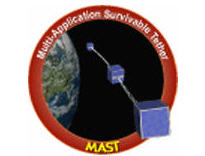 Readers of this blog have probably noticed a new logo and message on top of the blog’s sidebar, the logo and link to the MAST (Multi-Application Survivable Tether) mission, the latest project from Tethers Unlimited, Inc. This company, founded by Dr. Robert Hoyt (of Hoytether fame) and Dr. Robert Forward, will be launching a one-kilometer long tether into low earth-orbit. Each end of the tether will be anchored with a picosatellite, with a third picosatellite continuously traveling along the tether from one end to the other (and hey, one of them is named TED, this is a GOOD thing 🙂 ). The potential application here to a Space Elevator is obvious; how does a tether (even though it’s not the carbon nanotube ribbon envisioned by Dr. Brad Edwards) survive in space? Atomic oxygen, radiation, micrometeorites, etc., are all potential dangers. Everything we can learn about how they will affect structures like this will be valuable. This tether experiment was set to be launched on March 27th, but launch problems have pushed that date back to April 17th. Check out their blog (available by clicking on the icon on the top of my blog’s sidebar) for updates.
Readers of this blog have probably noticed a new logo and message on top of the blog’s sidebar, the logo and link to the MAST (Multi-Application Survivable Tether) mission, the latest project from Tethers Unlimited, Inc. This company, founded by Dr. Robert Hoyt (of Hoytether fame) and Dr. Robert Forward, will be launching a one-kilometer long tether into low earth-orbit. Each end of the tether will be anchored with a picosatellite, with a third picosatellite continuously traveling along the tether from one end to the other (and hey, one of them is named TED, this is a GOOD thing 🙂 ). The potential application here to a Space Elevator is obvious; how does a tether (even though it’s not the carbon nanotube ribbon envisioned by Dr. Brad Edwards) survive in space? Atomic oxygen, radiation, micrometeorites, etc., are all potential dangers. Everything we can learn about how they will affect structures like this will be valuable. This tether experiment was set to be launched on March 27th, but launch problems have pushed that date back to April 17th. Check out their blog (available by clicking on the icon on the top of my blog’s sidebar) for updates.
There is a very good story about this experment at NewScientistSpace.
 There is also another tether experiment set to be launched in May; this one a 30 kilometer long tether. From the press release;
There is also another tether experiment set to be launched in May; this one a 30 kilometer long tether. From the press release;
“One of the most important aspects of this innovative mission is the deployment of a 30 km long tether to deploy the Fotino mini-satellite and re-entry capsule. . Not only will this be the longest artificial structure ever deployed in space, but it will also be the first time that a tether has been used to return a payload from space. The flight is intended to demonstrate how such a tether can be used to change a satellite’s orbit without attitude control systems or rocket engines.”
This is very cool.
Both of these structures should be easily visible via binoculars or perhaps even the naked eye.
Marc Boucher at the Space Elevator Reference has been following these stories closely (here, here, here and here) including a couple of videos.

Pingback: What do silkworm moths, mice, tritons, lizards, snails and cockroaches have in common? - The Space Elevator Blog